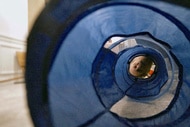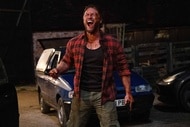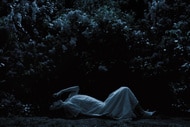Create a free profile to get unlimited access to exclusive videos, sweepstakes, and more!
Spiral director Darren Lynn Bousman on making horror with Chris Rock and his 'emotional' return to theaters

This week, one of 21st-century horror's greatest franchises returns to theaters with Spiral: From the Book of Saw, a new twist (pun intended) on the classic Saw splatter formula led by franchise newcomer Chris Rock. Though he's not necessarily known as a horror guy, Rock saw a way to inject some of his own energy into this punishing franchise, and to help him do it, he called in a Saw veteran responsible for three of the franchise's most successful films: director Darren Lynn Bousman.
For Bousman, who helmed Saw II, Saw III, and Saw IV but hasn't been part of the franchise since the fourth film in the series came out in 2007, the chance to work with Rock on a horror project was impossible to turn down, but working on Spiral was about more than a relationship with a star. As he stepped into the project, Bousman also found new opportunities within the franchise he spent so much time in years ago, and he hoped to find ways to push Saw in directions previous installments never had. On Friday, fresh off seeing the film play in front of midnight screening audiences, SYFY WIRE spoke to Bousman about shaping the story of Spiral, what Rock brings to a horror movie set, and the cathartic experience of seeing a scary movie with a crowd again.
You've mentioned before that you were on board as soon as you got the call from Chris Rock. How far along was the story when you came in?
Eighty percent there, 70 percent there. It was the same idea. I'll give you an example: The puppet wasn't in it, the pig puppet wasn't in it, the pig guy that captures people wasn't in it. None of the traps were in it. So what I did when I came in was really try to interconnect things more, and really try to push the final 15-minute payoff and go back to the beginning and put clues in there. So it was basically refining what they already had. And then once we got to that point, Chris would take the script and add his Chris Rock spin on things.
There's a definite relationship between horror and comedy in terms of timing and payoff. What does having Chris Rock on your set do to change the horror dynamic?
I mean, first off, he's probably the greatest living comedian right now. I think that he really had insight into how to put fans in a position that I would never know how to do. Meaning that if you have a constant sense of dread in the Saw movies, which I used to try to do — if you go back and watch Saw II, there's really no jokes in it, it's completely serious — Chris would know where to put something that allowed the audience to either breathe a sigh of relief or have a laugh. That pulls them in harder when we wanted them to be shocked or be scared.
We would do a scene and he would play it completely straight, completely serious. And then he'd say, "You know what, that's too serious. I got to do that again." And he'd do the exact same scene again, but add a button, like a joke in it. I watched it last night at the Alamo Drafthouse, which was awesome, and you'd see people completely silenced, laugh, and then go completely silent again. And it's like a roller coaster, right? You don't want to go on a rollercoaster that only goes in one direction, you want to go up and then down and then up and then around, then down. That's what makes roller coasters fun.
Police hunting a killer has always been part of Saw, but this one has a more procedural tone than past installments. How did that come about?
The idea of the police kind of procedural thing was there [in the script]. You know, one of the things to remember is this is not Saw IX. It is the ninth installment, but it's Spiral. We looked at when we were creating it: "What do we bring in from a familiarity standpoint, so it doesn't feel like a complete redo, and what do we get rid of?"
The two things that we had to get rid of were Jigsaw and [Billy] the puppet, which was the hardest thing for me. But if you're going to try to basically do a whole new movie, if you bring them in, it becomes Saw IX. So we got rid of those. And then we said, "OK, you know, almost all the films have the B or C storyline being the police. So let's take that idea and make it the A storyline, which goes back to a little bit of what Saw one did.
I think that Chris was really fascinated with 48 Hrs. as well — that buddy cop 48 Hrs. feel. And I always thought 48 Hrs. was a comedy until I rewatched it. And it's not a comedy, it's a balls-to-the-wall, violent police action film that happens to have Eddie Murphy in it. And Eddie Murphy's funny. So I think that he was a huge fan of 48 Hrs., and that was one of his big inspirations. So we just leaned into the police on that side, since we knew that Saw movies have used police as an undertone, we just leaned into it.
The Saw franchise tends to touch a lot of cultural nerves, and this time it's dealing with corrupt policing. How does that feel in the context of the last year?
Well, it was weird. One of the things that I think people need to realize is the movie was written in 2018, shot in early 2019, and finished five months before the tragic [police killings] of either George Floyd or Breonna Taylor. It just became more timely as it sat there. But I guess the sad answer to the question is this isn't a new thing. This was happening two years ago, it was happening three years ago. So it just felt like something topical then as well, to hit.
We wanted to expand the Jigsaw message, and the Jigsaw message was reforming an individual, taking someone, whether that was a drug addict or [someone] capitalizing on pain, and putting them through a series of tests to reform them, make them someone different. So we thought that the evolution of that message was not reforming an individual, but reforming an institution. I kind of liked the idea that even though he's picking out these separate police officers, he's putting a light on all the police officers and he's making them all paranoid. And I think that's cool because if you take a singular person off the street, Amanda [from the first three Saw movies], and you put her in the trap that becomes her trap, it's her story. But when you take these institutions, everyone is fearful. They all begin to go back and look at their lives. So I just thought it was a really cool progression of the Jigsaw message.
Earlier this week you got to see the movie with audiences, many of whom were probably at their first movie in a year. What's the experience of rolling this movie out been like so far?
Last night had an emotional impact on me a little bit in a way. First off, I'm back in [Austin's Alamo Drafthouse] South Lamar, where I premiered two of my movies — Repo! The Genetic Opera, and a movie called Mother's Day — a decade ago. Now I'm back in the same exact theater that I was back then, but we're in a different world now, right? The world has changed, but the thing that hasn't changed is the communal movie-going experience, to sit in that theater, when the lights dimmed and you smell the beer, the stale smell of beer, you saw the pizzas and the popcorn, and you heard the laughing.
It was like, "That's the light at the end of the tunnel that I've been waiting for," to basically congregate again with like-minded weirdos, to sit in a dark theater and have this communal experience. It was emotional for me because what happened over this last year was isolation. We were isolated, we were alone, and I think that going to the theater last night was that light that I've been looking for the last 15 months. And there I was sitting in the theater hearing the reactions, the cheers, the boos, the claps, the groans, and to me, it was, it was just an awesome experience.
This interview has been edited and condensed.
Check back on Monday for more from our chat with Bousman, including Spiral spoilers.


























